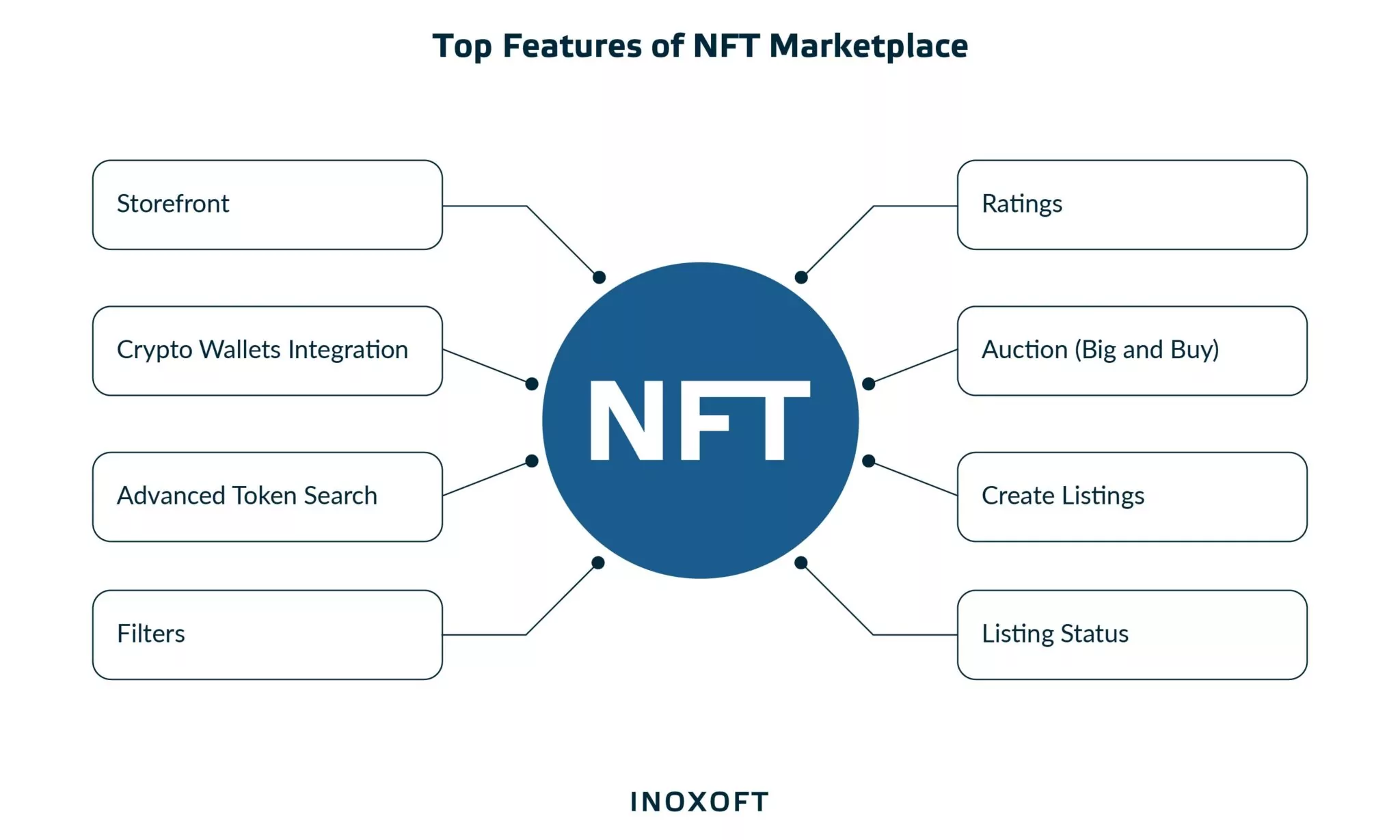Today, building an NFT marketplace looks like a worthy investment: it has emerged as crucial hubs for creators and collectors alike. But before jumping into this fascinating project, it’s a good idea to make preliminary estimations. How much does it cost to start an NFT marketplace?
Luckily, we at Inoxoft can guide you through all those nuances. Dwelling on our solid experience in NFT marketplace app development and blockchain solutions, we will reveal the cost to build a NFT marketplace in 2024. Ready? Let’s get started!
- What is an NFT Marketplace?
- The Cost of Different NFT Marketplace Types
- Open and premium marketplaces
- Curated and non-curated marketplace
- Games marketplace
- Collectibles marketplace
- Other Factors That Affect NFT Marketplace Development Cost
- Blockchain Platform
- Features and functionalities
- Design and user experience
- Development team
- Timeframe and project complexity
- Marketing and promotion
- Legal and regulatory compliance
- Security and audit
- Is There a Difference in the NFT Marketplace Development Cost Among Software Companies?
- Final Thoughts
What is an NFT Marketplace?
An NFT marketplace is a digital platform for buying and selling NFTs. It allows people to store, display, and mint their digital assets, plus trade with crypto or fiat currencies. Unlike with fungible tokens, NFTs are based on blockchain technology, so people can’t trade them in standard online stores. Instead, that’s only possible with an NFT marketplace. Besides, such solutions are convenient for artists tokenizing their art pieces and collectibles.
One of the primary specifics of NFTs is their versatility. In particular, a marketplace can involve different types of non-fungible tokens, such as art, music, media, real estate, and gaming. Also, such platforms should be transparent and accessible to customers. In particular, they display clients’ actions in real time and guarantee transactions’ security.
While the NFT market constantly evolves, new platforms of different types emerge. However, several giants own the lion’s share of the industry. Here are the key NFT marketplace players by the percentage of their dominance.
Now that you know the main specifics of an NFT marketplace, let’s break down different types of such solutions.
The Cost of Different NFT Marketplace Types
NFT marketplace development cost varies depending on the platform’s type and purpose. That’s because each requires different features, technologies, and integrations. Let’s consider the four most common categories of NFT marketplaces and reveal their average development prices.
Open and premium marketplaces
It’s one of the most widespread NFT marketplace types. Such platforms are available to anyone as they gather various sources in a single open market. However, open marketplaces have fewer premium features than closed ones. OpenSea is the most famous example of an open NFT marketplace. The price of such a project varies from $50,000 to $150,000.
Curated and non-curated marketplace
Curated marketplaces are ideal for artists who want to sell their works. But to do that, they should get authorized on the platform. In contrast, non-curated marketplaces don’t require verification, making artwork trading more accessible. The most well-known marketplaces of this type are Netflix, Spotify, and Cargo. The price of such a project varies between $80,000 and $200,000.
Games marketplace
Today, the gaming industry is closely related to the world of NFTs. Unsurprisingly, there are marketplaces where users can trade game assets. For instance, these are Axie Infinity, The Sandbox, and Decentraland. Such a project may cost you somewhere between $100,000 to $500,000.
Collectibles marketplace
Such marketplaces perfectly suit collectors trading various types of digital artworks. Some examples of NFT collectibles platforms are NBA Top Shot, CryptoPunks, and Solanart. To develop a similar product, you’ll need to invest from $60,000 to $250,000.
We have prepared a table to summarize the information about NFT marketplace development cost, depending on its type:
|
NFT Marketplace Type |
Example |
Average Development Cost |
|
Open and Premium Marketplace |
OpenSea, Rarible, Foundation |
$50,000 – $150,000 |
|
Curated and Non-Curated Marketplace |
Netflix, Spotify, Cargo |
$80,000 – $200,000 |
|
Games Marketplace |
Axie Infinity, The Sandbox, Decentraland |
$100,000 – $500,000 |
|
Collectibles Marketplace |
NBA Top Shot, CryptoPunks, Solanart |
$60,000 – $250,000 |
Other Factors That Affect NFT Marketplace Development Cost
Blockchain Platform
The cost of NFT marketplace development significantly depends on the chosen blockchain platform. Let’s overview the most popular options:
- Ethereum. It’s the prominent blockchain platform for NFT marketplaces due to its smart contract capabilities and large developer community. However, the cost of developing on Ethereum is higher because of the high gas fees associated with transactions and deployment.
- Polkadot. Polkadot is a relatively new blockchain platform offering interoperability between blockchains. Due to its complex architecture and the need for specialized development skills, creating an NFT marketplace with Polkadot can be more costly.
- Binance Smart Chain. Binance’s solution is a popular alternative to Ethereum due to its lower gas fees and faster transaction times. Developing an NFT marketplace on Binance Smart Chain is more affordable. Hence, it’s a popular choice for smaller projects.
- TRON. TRON is a blockchain platform that enables high-speed and low-cost transactions. It has small transaction fees, and all development tools and resources are open-source.
- HECO. HECO is a relatively new blockchain platform providing an affordable and scalable solution for decentralized applications. It’s more cost-efficient because of the low transaction fees and the availability of development tools and resources.
Features and functionalities
Your NFT marketplace’s complexity and the required features also affect its development cost.
Some of the essential functions of an NFT marketplace include a user-friendly interface, a search function, an NFT gallery, a bidding system, a payment gateway, and a smart contract system. Additional features like analytics, social media integration, or customization options can also be beneficial. However, they will increase the development price.
Here are some essential functions to consider when estimating your NFT marketplace development budget.
- Storefront. The storefront is like an opening dashboard helping users navigate through your marketplace. It should contain NFTs’ price history, owner, and other crucial information.
- Filters. With the help of filters, users can easily find what they need on your platform. For example, they may choose the product’s price and type that suits them.
- Listings. The ability to create listings with product details is a convenient feature for both sellers and customers.
- Wallet. Thanks to this function, users can manage their NFTs and crypto transactions. You can create your custom wallet or use a ready-made solution.
- Auctions and buying. The NFT buying system streamlines the trading process for users. Auctions, in turn, enhance user engagement and drive more sales.
All those features are highly beneficial if you want to make your NFT marketplace stand out from the stiff competition. But, of course, implementing them affects the cost of building an NFT marketplace.
Now, let’s look at some critical stages of the NFT platform development lifecycle and their influence on your project’s budget.
Design and user experience
UI (User Interface) and UX (User Experience) determine how users interact with your platform. Here are some details on how it can impact the development cost:
- Design complexity. Designing a unique, engaging, and easy-to-navigate user interface requires additional time and resources, increasing the project’s cost.
- Customization requirements. You may need customized features like personalized avatars, unique NFT display options, and complex search algorithms. Implementing them demands extra design and development effort.
- Compatibility with different devices. The NFT marketplace design should be responsive and compatible with mobile phones, tablets, and computers. However, to reach this goal, you should also make some extra investments.
- User testing. Testing your product during design is critical for ensuring a positive user experience. It helps identify potential issues and improvement areas but affects the project’s cost.
Development team
The cost of NFT platform development depends heavily on the team‘s specifics:
- Expertise. A team with extensive experience developing blockchain-based applications and NFT marketplaces requires a higher salary. However, reducing the overall project cost will require less time and resources. Besides, such a team’s performance is much more efficient.
- The number of team members. A larger team can handle a more significant workload, accelerating development time. On the other hand, hiring more professionals leads to increased labor expenses.
- Location. The team’s location also impacts the development budget. That’s due to the difference in salaries, living costs, and availability of skilled talent in various regions.
- Communication and collaboration. Agile methodologies prioritize flexibility and adaptability, reducing the total development cost. The team responds to changes and feedback more efficiently, leading to shorter timelines and minimized issues.
Timeframe and project complexity
The more complex the project, the more time and resources it requires. Similarly, if your deadlines are tight, you will need more specialists to meet them, increasing the development cost.
Marketing and promotion
Marketing and promotion are essential factors affecting the development cost of an NFT marketplace:
- Advertising and PR. Advertising and PR campaigns require resources, including marketing professionals, advertising space, and public relations personnel. The marketing team should allocate a sufficient campaign budget to increase the visibility of your NFT marketplace.
- Social media presence. Creating a powerful social media influence boosts marketplace success. However, you should dedicate more time and effort to growing social media accounts and engaging with the audience.
- Community building. Building a community requires significant resources. It includes community managers and moderators, community events, and giveaways.
- Influencer marketing. Influencer marketing is another efficient but expensive way to promote an NFT marketplace through popular social media accounts and other channels.
Legal and regulatory compliance
Now, let’s dive deeper into some details on how legal and regulatory compliance can impact the NFT marketplace development cost:
- Research and analysis. NFT marketplaces may have to follow data protection and privacy regulations depending on the jurisdiction. Researching and analyzing those aspects require time investments and legal professionals’ assistance.
- Licensing and permits. Obtaining licenses and permissions for establishing an NFT marketplace also boost the overall development expenses.
- Compliance with AML and KYC regulations. You will need expert help and specific software to make your marketplace comply with Anti-Money Laundering (AML) and Know Your Customer (KYC).
- Intellectual property rights. An NFT marketplace shouldn’t violate any intellectual property rights of third parties. Thus, the development team must ensure that the NFTs listed on the platform are authentic and legally valid.
- Data protection and privacy regulations. Depending on the jurisdiction, NFT marketplaces may have to follow data protection and privacy regulations. It also requires legal professionals and software involvement.
Examples of legal and regulatory compliance requirements for NFT marketplaces include the following legislations:
- Securities and exchange commission (SEC) regulations in the United States for securities offerings
- General data protection regulation (GDPR) in the European Union for data protection and privacy
- Financial action task force (FATF) regulations for AML and KYC compliance
Security and audit
Security and audit also affect the development cost of an NFT marketplace. Let’s look at those requirements in more detail.
- Security protocols. Implementation of two-factor authentication and other security measures increases development expenses.
- Audit and testing. The costs of penetration testing, vulnerability testing, and code audits depend on the size and complexity of your platform.
- Insurance. NFT marketplaces may require insurance to protect against cyber-attacks and other security breaches.
- Compliance with security standards. Compliance with the Payment Card Industry Data Security Standard (PCI DSS) for credit card transactions needs the assistance of security professionals and dedicated software.
Is There a Difference in the NFT Marketplace Development Cost Among Software Companies?
You may ask: “How much does it cost to create an NFT marketplace depending on the development company?” The truth is different software companies provide various services, and their expertise also varies. These factors will definitely influence the cost of your NFT marketplace. So choosing an appropriate vendor is definitely a critical step. However, the main features used in the development process have similar prices in every company. Here is the list of the most popular NFT marketplace development service providers.
Final Thoughts
The cost of creating an NFT platform varies depending on multiple factors, from your marketplace’s type, scope, and features to the hired developers’ location and experience. On top of that, it’s nearly impossible to estimate the exact development price without considering the specifics of your project. However, you may consider the most crucial factors and approximate estimations we shared in this article.
Finally, choosing a tech partner for your project can make or break your NFT marketplace’s success. Of course, a reliable vendor with the relevant expertise and a team of skilled professionals in place requires more investments. However, such a partnership will pay off in the long run. In particular, experienced developers will spend less time and resources on complex tasks, meet project requirements, and deliver the expected results.
Looking for a trusted and professional vendor? Turn to Inoxoft! Our software development company provides top-notch blockchain-based solutions for clients worldwide. We can turn your startup idea into reality and make the most of your business plans. Get in touch with our experts to discuss the cost of your particular NFT development project, considering its individual requirements.
Frequently Asked Questions
Are NFT marketplaces popular today?
The NFT industry is one of the most promising and innovative these days. According to the latest statistics, the non-fungible token market’s revenue is expected to reach nearly $8 million by 2027. Therefore, the interest of businesses and investors in building NFT marketplaces keeps growing.
What should I do before I make my own NFT marketplace?
Before developing your own NFT marketplace, you should choose the type of NFT marketplace, consider the essential features and technologies for your project, and estimate your budget.
How to estimate the cost of the NFT marketplace business model?
Many factors may affect your NFT platform development project’s costs. These are the complexity of the business model, required features, tech stack, maintenance cost, compliance with particular regulations, and more. To learn more details, check out this article.











